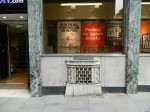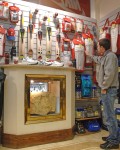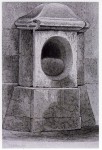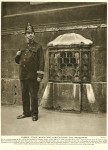From the History Blog:
 London Stone doesn’t look like much. It’s an irregular chunk of oolitic limestone hidden behind a grate on the footing of a 1960s building on Cannon Street. A bronze plaque above the grating is the only hint that it’s worth peering through penumbra to the object within. To actually see the stone, you had to go inside whatever business was occupying the storefront — at various times a Bank of China branch, a sporting goods store and most recently a WH Smith — and look into a knee-high glass case. The case wasn’t even visible when it was in a WH Smith because it was blocked by a magazine rack.
London Stone doesn’t look like much. It’s an irregular chunk of oolitic limestone hidden behind a grate on the footing of a 1960s building on Cannon Street. A bronze plaque above the grating is the only hint that it’s worth peering through penumbra to the object within. To actually see the stone, you had to go inside whatever business was occupying the storefront — at various times a Bank of China branch, a sporting goods store and most recently a WH Smith — and look into a knee-high glass case. The case wasn’t even visible when it was in a WH Smith because it was blocked by a magazine rack.
 Yet, this unpreposessing rock has an illustrious history. Its origins are unknown, and that mystery has birthed uncounted legends, rumors and myths, most of them invented in the past 150 years. It’s been said to be the stone from which Arthur drew the sword that made him king, a druidic altar, a piece of the palace of the Roman governor of Londinium, the plinth for the Palladium brought to the city by Brutus of Troy, legendary founder of London and a fetish stone installed by the first prehistoric settlers of what would become London. A slightly more realistic theory is that it was the milliarium of Roman London, the stone marker in the precise center of the city from which all the miles in Britain were counted.
Yet, this unpreposessing rock has an illustrious history. Its origins are unknown, and that mystery has birthed uncounted legends, rumors and myths, most of them invented in the past 150 years. It’s been said to be the stone from which Arthur drew the sword that made him king, a druidic altar, a piece of the palace of the Roman governor of Londinium, the plinth for the Palladium brought to the city by Brutus of Troy, legendary founder of London and a fetish stone installed by the first prehistoric settlers of what would become London. A slightly more realistic theory is that it was the milliarium of Roman London, the stone marker in the precise center of the city from which all the miles in Britain were counted.
![]() There’s no more evidence for the plausible theories than for the fantastical ones. The stone appears on the historical record in the Middle Ages. It was installed on the south side of what was then known as Candlewick Street (Cannon Street isn’t about the weapon; it’s just the end-product of centuries of usage alterations from the original Candelwrichstrete), held to the ground with large iron clamps. Most of it was below the surface.
There’s no more evidence for the plausible theories than for the fantastical ones. The stone appears on the historical record in the Middle Ages. It was installed on the south side of what was then known as Candlewick Street (Cannon Street isn’t about the weapon; it’s just the end-product of centuries of usage alterations from the original Candelwrichstrete), held to the ground with large iron clamps. Most of it was below the surface.
A gospel given by Æthelstan (924–939), the first king to rule of all of England including the Viking north, to Christ Church, Canterbury, has a reference to a piece of land belonging to the church that is “neer unto London Stone.” That suggests London Stone was famous enough already in the 10th century to be used as an identifying landmark, and it continued to be a key geographical reference for centuries. A document from the reign of Stephen (1135-1154) records a fire starting at a house “neere unto London Stone.” It is repeatedly mentioned in official records to describe the locations of buildings. It was also a popular moniker for people who lived in the neighborhood (a certain John de Londenston stabbed his wife Agnes in 1241) and for drinking and eating establishments. There was an Old London Stone Coffee House, a London Stone Tavern and a London Stone Eating House which was said to be the first house built after the 1666 Great Fire of London.
 It wasn’t just a convenient marker; it was held in high esteem. A house on the north side of St Swithin’s church, the home of London’s first Mayor Henry Fitz Aylwin and the seat of government from 1189 to 1212, was considered highly prestigious because it was near the stone. Jack Cade, leader of a popular rebellion against King Henry VI in 1450, entered London on July 3rd and made a point of going to London Stone where he struck it with his sword and declared himself lord of the city. Shakespeare describes it colorfully in Henry VI, Part 2:
It wasn’t just a convenient marker; it was held in high esteem. A house on the north side of St Swithin’s church, the home of London’s first Mayor Henry Fitz Aylwin and the seat of government from 1189 to 1212, was considered highly prestigious because it was near the stone. Jack Cade, leader of a popular rebellion against King Henry VI in 1450, entered London on July 3rd and made a point of going to London Stone where he struck it with his sword and declared himself lord of the city. Shakespeare describes it colorfully in Henry VI, Part 2:
[Enter JACK CADE and the rest, and strikes his staff on London-stone.]
CADE: “Now is Mortimer lord of this city. And here, sitting upon London-stone, I charge and command that, of the city’s cost, the conduit run nothing but claret wine this first year of our reign.
(Cade claimed descendance from the powerful Mortimer family.)
After the Great Fire leveled much of the city, the stone’s foundations were exposed for the first time in hundreds of years. Its large dimensions suggested London Stone must have been part of a monumental feature of some kind. The fire may also have damaged it, cracking it apart. Five years after the fire, the Worshipful Company of Spectacle Makers were compelled by court order to destroy a faulty batch of 264 pairs of eyeglasses by dashing them against London Stone. The guild’s records say they were broken “on the remayning parte of London Stone.”
 By 1742 the stone was obstructing traffic in what was then a narrow lane, so it was moved to the north end of the street and installed in the wall next to the door of St. Swithin’s church. In A Journey from Birmingham to London (1785) by W. Hutton, the author observes that the residents pay little attention to the stone.
By 1742 the stone was obstructing traffic in what was then a narrow lane, so it was moved to the north end of the street and installed in the wall next to the door of St. Swithin’s church. In A Journey from Birmingham to London (1785) by W. Hutton, the author observes that the residents pay little attention to the stone.
The small information received from history and the smaller from tradition, prove its great antiquity. This curiosity is as little regarded as known. The numerous crowd of passengers take less notice of this stone than of those upon which they tread. My enquiries were answered with a supercilious smile, and all the intelligence I could gain was, “It is a place of rest for the porters burden.” […]
This Stone appears of a marble texture near four feet high, two broad, and one thick. An ornament at the top is broken off. In the front is an oval aperture or recess two feet long, at the bottom of which is a broken fragment which has supported perhaps an image or urn, expressive of the original design. Time seems to have destroyed the lower part of the oval, and art has supplied the place with a patch.
 In 1798, the stone was moved again to the east side of St. Swithin’s south wall and in 1820 it was set into an alcove in the center of the south wall. It rested there for 120 years, a much-visited tourist attraction. Then came World War II and the Blitz. St. Swithin’s was destroyed, but the walls, and the stone embedded in one of them, still stood. The ruins of the church were finally demolished in 1962 and the current building was erected with the sad, gloomy little grilled out alcove as the ignominious dwelling for the former celebrity stone.
In 1798, the stone was moved again to the east side of St. Swithin’s south wall and in 1820 it was set into an alcove in the center of the south wall. It rested there for 120 years, a much-visited tourist attraction. Then came World War II and the Blitz. St. Swithin’s was destroyed, but the walls, and the stone embedded in one of them, still stood. The ruins of the church were finally demolished in 1962 and the current building was erected with the sad, gloomy little grilled out alcove as the ignominious dwelling for the former celebrity stone.
Now that building too is slated for demolition, only this time London Stone will be treated with the respect due.
Planning permission has been granted for the demolition of the building and the erection of new premises on the site, to include a special raised plinth so that the artefact can be viewed by the public. During the building works, it is hoped that London Stone will be displayed in the Museum of London for about 20 months from late spring. […]
While it is at the museum, research will be carried out in an attempt to define its geology, which may help to explain its origin and purpose. But the likelihood is it will remain, to paraphrase [author Iain] Sinclair, an object that everyone agrees is significant, even if no one quite knows why.
And perhaps that is the way it should be. According to [the Museum of London’s John] Clark: “It is a mysterious and mystic object. I’m not sure if we want to know what it really was; in the end, that would spoil it.”
- Like
- Digg
- Tumblr
- VKontakte
- Buffer
- Love This
- Odnoklassniki
- Meneame
- Blogger
- Amazon
- Yahoo Mail
- Gmail
- AOL
- Newsvine
- HackerNews
- Evernote
- MySpace
- Mail.ru
- Viadeo
- Line
- Comments
- SMS
- Viber
- Telegram
- Subscribe
- Facebook Messenger
- Kakao
- LiveJournal
- Yammer
- Edgar
- Fintel
- Mix
- Instapaper
- Copy Link







